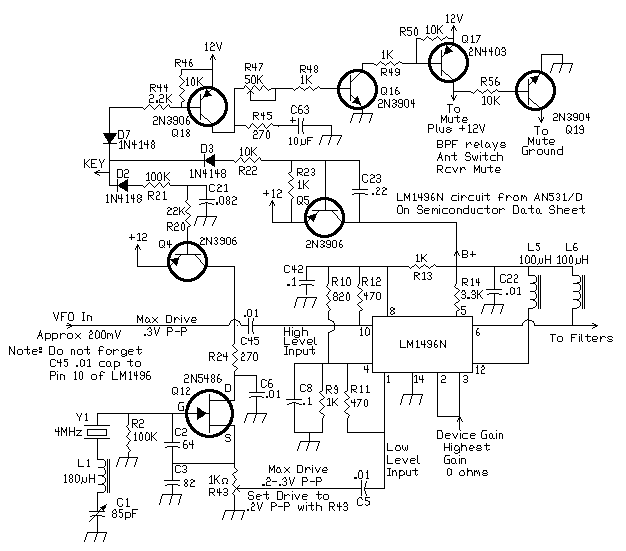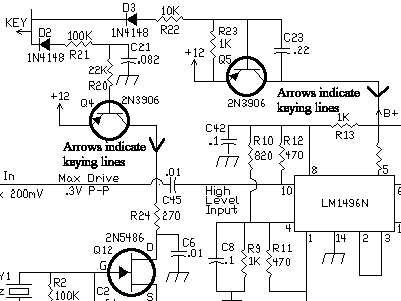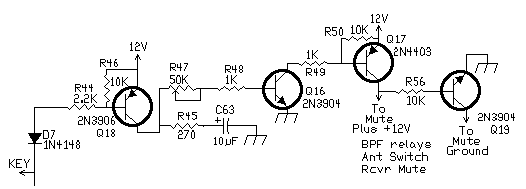

|

|
A design for 40 and 30 meters will be presented. Modifications are very easy to incorporate into the design. Be sure to include capacitor coupling (.01) between the stages. The inputs and outputs of the LM1496 and the input to the 2N5109 have bias voltages that must be protected for proper operation. Shielding should be used between the stages. Use shields that are as high as the circuitry enclosed. Keep the LM1496 section as far away from the DL-QRP-PA as is practically possible. |

|
A double balanced Gilbert cell mixer, the LM1496N, is used to interface with a receiver. Since drive levels for the mixer are so low (~100mV to 200mV), a very low value capacitor (3.3pf would be a good starting point) can be used in the receiver to pick up the VFO signal. Low coupling capacitance minimizes pulling the dial calibration of the receiver. Cable length also plays a factor in the attenuation of the signal from the receiver. Be careful of really long cable lengths from the receiver to the 1496 that may lower signal strength too much. The LM1496 output circuit comes from the AN531/N On Semiconductor datasheet. The output circuit with the 2 RF chokes and single ended output allows a broadband output in the HF frequency range. The broadband output of the LM1496 allows any combination of frequencies at the inputs of the LM1496. Make sure you don't have an in-band signal by mathematically running your mixer products to the third product. An example is using a 3.547 MHz crystal with a 10.547 MHz VFO for 40 meters. The 3.547 MHz crystal doubled to 7.094 MHz - right in the middle of the band! The VFO input for this schematic is 14 MHz with a 4 MHz oscillator for operation on 30 meters and an 11 MHz VFO for operation on 40 meters. The VFOs are switched in the receiver for the two bands when used with the Electroluminescent Receiver. The frequency of the crystal in the oscillator, added to or subtracted from the VFO, generates the frequency of the transmit signal. If the receiver is a single conversion superhet, the first oscillator of the receiver might be used. Use the receiver oscillator signal (with a coupling capacitor for .2V P-P drive) in place of the oscillator and input into Pin 1. However, the receiver oscillator may not place the output signal at the right offset for CW operation unless the oscillator is pulled with a switched varactor or capacitor in the oscillator tank circuit. If the oscillator (Q12) is the same frequency as the crystal filter in the receiver, shielding the oscillator will prevent it from getting into the receiver. No problem with chirp or pulling was noticed with this design. Crystals can be ordered from ICM (Oklahoma City, OK) or Peterson's crystals at reasonable prices. L1 and C1 can be used to pull the crystal to get the proper offset for CW operation. The 180uH value for L1 was the best value for pulling a 4 MHz crystal. For standalone operation, build the VFO for one-half the frequency you want to use, feed both inputs to the LM1496 and let it double the frequency of the VFO. A low frequency VFO has better stability.  The circuitry near the top of the schematic (Q5) (shown above) is the shaping circuit for keying the LM1496 and and the shaping circuit (Q4) for keying the oscillator. The oscillator is keyed slightly before the 1496 so the oscillator has time to stabilize before the 1496 mixer is turned on. The delay time is in milliseconds with R21/R20/C21/ with Q4 and R22/R23/C23 with Q5 determining the timing and shaping of the keying. The schematic in the Flying Pigs article showed Q4 also supporting the mute function for the receiver. That upset the timing for the oscillator and was removed. Q4 is dedicated to the oscillator and can't be used for anything else. The mute function was moved to Q17 along with Antenna switching and relay switching of the bandpass filters (when used with the ELR). See the schematic below. |
